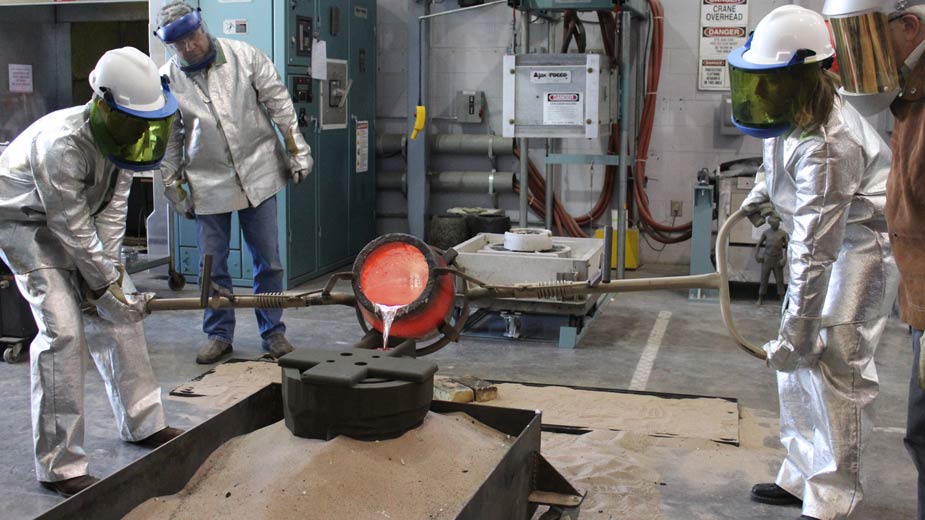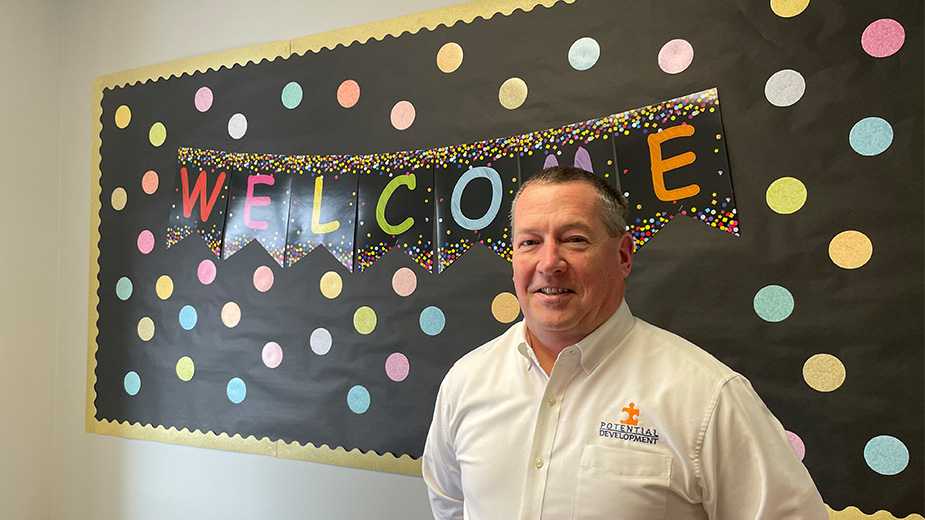YSU Launch Lab Pours Sculpture into 3-D Mold
YOUNGSTOWN, Ohio – At first, it seemed that the pouring of molten aluminum for Daniel Newman’s parakeet head sculpture had gone perfectly. Newman, along with a small group of Youngstown State University students and faculty from the engineering and arts disciplines, watched as the metal cooled in a 3-D-printed mold.
Slowly, though, cracks began to appear on the outside of the mold as smoke rolled out.
“I think it’ll come out fine. We might have some small flashings that can be chased out, but it’ll look good,” said Greg Moring, chairman of the YSU art department and one of Newman’s sculpture professors. “It’s a learning experience, both for the students and faculty. We’ve just started using the 3-D sand printer, so we’re experimenting with how it works.”
Newman, a senior majoring in sculpture, first saw aluminum pouring in Bliss Hall last semester and it was there that he started talking to engineering students about working together on a project. Over the months, he finalized an 18-inch clay parakeet head sculpture that was then scanned in YSU’s 3-D printing lab across campus in Moser Hall. Then, the data was sent to YSU’s printer at Humtown Industries in Leetonia, where the mold was printed.
On Monday afternoon, Newman, Moring and several other representatives from the arts and engineering programs gathered for a “pour party” organized by YSU’s Launch Lab program. The lab, started in 2008, is a collaboration between the College of Creative Arts & Communication, College of Science, Technology, Engineering and Mathematics, and the Williamson College of Business Administration. Students in the three colleges work together on cross-disciplinary projects.
“You make one sculpture and it’s nice. Maybe you sell one for $50. But what if you could sell them at $50 times 2,000?” asked Brian Vuksanovich, a mechanical engineering professor who helped with the pouring. “If we can make it repeatable and economical, then we have something you’re passionate about and can become a career because you have something to sell.”
By bringing together STEM students, artists and business majors, they learn from each other and educate each other about the various aspects of a project, he explained, which can then be applied to real-world experiences. Vuksanovich has worked with Launch Lab since 2009.
“They are different worlds. We have the strength of the creative arts side and the more technical side. It gives you experience with social skills,” Newman said. “With any professional field, you have to collaborate with people. It’s important to work with other people and go outside the box, maybe work with someone who has a skillset that you don’t.”
Aside from Newman’s sculpture, students also poured aluminum for a manhole cover and a test mold for a penguin sculpture. For the latter, Monday’s aluminum pours were tests for a brass sculpture that will sit atop the steam whistle used at YSU football games.
To produce the 40-pound parakeet sculpture, the group first had to melt the aluminum at around 1,450 degrees in a crucible designed through a collaboration between YSU students and Warren’s Ajax Tocco Magnethermic Corp. Melting that much aluminum takes about 30 minutes. Once it’s molten, two people work to pour the metal into the sand mold. Pour too fast and it can overflow. Pour too slow and the metal will drop below its melting point and harden in the crucible.
“We were trying to pour around 1300 degrees, so we tapped it around 1450. That’s so as we transfer the crucible out, it can cool a little bit,” Vuksanovich explained.
After the pouring was done, the group gathered around the mold and examined the casing, which cracked as the metal started to cool.
“In this case, the walls were a little too thin and couldn’t hold a solid without cracking,” Moring said. “The best way you learn is through mistakes. One of the best things between the art and engineering students is to analyze what we didn’t do this time so we can change it for next time.”
The advantage of using 3-D printed molds for metal sculptures, Moring and Newman say, is the ease of use. Newman is most familiar with the lost wax method of making molds, which requires a dozen or so steps. For his sculpture, he simply made the prototype, had it scanned and a mold was made.
“The process is a lot more involved, so it’s streamlined a bit. And it’s a chance to use this new technology, too, which I was excited about,” he said.
Sand molds have long been used in sculpting, Moring added, but with 3-D scanning and printing, the end result is much more true to the artist’s original.
“It’s far more accurate, a lot cleaner,” he said. “In the arts, typically, you hand mix that bonded sand and hand-pack it. This is nice because the precision is so high.”
Copyright 2024 The Business Journal, Youngstown, Ohio.



